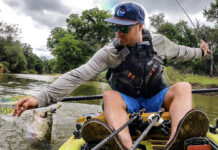When days get shorter and the weather cools, river bass instinctively turn their attention to feeding for winter. Water in these areas is fast and furious but so is the fall fishing. Kayak Angler spoke to a trio of hot-shot anglers who successfully target late-season river bass in the fast-moving water of their local flows. It took a little coaxing, but these pros eventually gave up some of their best tips on how to catch big bass in the fall.
How to Catch River Bass in the Fall
In early fall, smallmouth, shoal bass and spotted bass are in their summer locations. Look for the fish near rock gardens, ledge systems and just below rapids where the water is rich with oxygen. Mixing water flow and rock structure provides ideal ambush points for bass to wait as baitfish and other prey pass.
Look for fast-moving funnels of water pointing towards down river chutes terminating in deeper pockets or pools. Water depth over four feet is optimal. The river bass like the oxygen content of the fast-moving water but also need deep water nearby to feel safe. For more, we turn to our fall bassin’ experts for their late season tips.

Tim Perkins | Alabama | Two-time River Bassin’ Tournament Trail champion
Spotted Bass
Rod: Six-foot, six-inch, medium-heavy, fast-action Abu Garcia Veritas
Reel: Abu Garcia Revo SX high speed 7:1 retrieve ratio
Line: 30-pound braided line with five feet of 15-pound fluorocarbon leader
Lure: Lake Fork Magic Shad rigged on an eight-ounce Owner Beast swimbait hook
Run the Wood
To find King Kong spotted bass, look for submerged trees along current seams. Fish the downstream side of the wood first then hit the upstream side. Let the lure sweep through the waves stacking up in front of the deadfall.
First cast, keep the bait moving in the top third of the water column. Spotted bass will often flash at the bait without connecting. If the spotted bass shows itself, make a second cast, but this time slow the retrieve a little. Many times, a small adjustment in speed will be enough to fool the bass.

Allen Ragsdale | Alabama | Fall Line Guide Serve
Shoal Bass
Rod: Seven-foot, medium-heavy, fast-action baitcast rod
Reel: 7:1 retrieve ratio baitcast reel
Line: 20 pound Berkley Big Game
Lure: Zara Spook medium or large, color doesn’t matter it’s about the presentation
Skip a Walking Lure
Target current seams, push water in front of boulders, small pocket water among the shoals.
Walk the Zara Spook through calm water pockets. When the lure hits the current, reel fast while snapping the rod tip a few inches to skip it across the fast water. Shoal bass will hammer the bait. If the fish misses, follow-up with a nose-hooked weightless fluke.

Juan Veruete | Pennsylvania | Wilderness Systems Pro Guide
Smallmouth Bass
Rod: Medium-power, fast-action, seven-foot Temple Fork Outfitters spinning rod
Reel: High speed 7:1 retrieve ratio spinning reel pulling 31 inches of line per turn
Line: 6/20 Power Pro with 10 pound, five-foot fluorocarbon leader connected with a uni-to-uni knot
Lure: Fitt Custom Lures counter rotating buzzbait with no skirt and a black curly tail trailer. The black color creates a better silhouette on the surface. Make sure your trailer isn’t too big or the buzzbait will swim on its side.
Buzzing Chutes
Target the larger deeper chutes of water funneling between rocks.
Position the kayak in an eddy off to the side of the chute. Fan cast a buzzbait to the smooth water at the top of the funnel and crank the bait down and across current. Move the lure faster than the current so the propeller spins. The high-speed reel and lift of the counter rotating blades keeps the lure buzzing on the surface. Close the bail by hand just before the bait hits the water to go directly into the retrieve. Fan cast to an eddy on the other side of the chute and retrieving your bait across the tail of fast water. Typically working the wave train from top to bottom is the best strategy. Fall smallmouth hold deep under the rapid in a micro eddy. They also like a current seam.
This article was first published in the Fall 2018 issue of Kayak Angler Magazine. Subscribe to Kayak Angler Magazine’s print and digital editions, or browse the archives.
River bass like the oxygen content of fast-moving water, but also need deep water nearby to feel safe. | Feature photo: Courtesy of Allen Ragsdale








